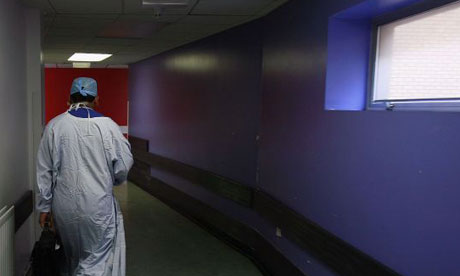Huge disparity in NHS death rates revealed
Patients less likely to die in bigger hospitals, reveals exclusive Guardian investigation

Doctors in the NHS do not know how well they are performing and whether they are more likely than their colleagues to kill or cure their patients, because of a widespread failure to collect the information, a Guardian investigation reveals.
The results of a major exercise looking at one particular procedure – vascular surgery – show a massive variation in death rates among patients admitted for planned operations and reveal that some hospitals have unacceptably high mortality.
It demonstrates the case for the closure of small hospital units, which the government has put on hold. Death rates vary from less than one in 50 in some hospitals to more than one in 10 in others.
The investigation reveals the hollowness of patient choice, which the coalition, like Labour before it, has made the centrepiece of NHS policy. The data amassed by the Guardian from surgeons at 116 hospital trusts after an extensive freedom of information trawl is not publicly available – and is at odds with what appears on the NHS Choices website, set up to help patients choose where to be treated.
The Guardian investigation focused on vascular surgery, where there is a significant risk of dying in planned operations, but the conclusions apply to every other branch of medicine – with the exception of heart surgery, where doctors collect and publish their individual results. They embraced transparency following the Bristol babies scandal in the late 1990s, when doctors were struck off the medical register over the deaths of babies who underwent operations for heart defects that they might have survived at other hospitals.
The investigation reveals that:
• More than a decade on from Bristol, doctors are failing to collect and publish data that would tell them and their patients how well or badly they are doing and allow patients to chose a hospital where their risks are lowest.
• Death rates in planned vascular surgery for abdominal aortic aneurysm (AAA – to prevent a burst artery) vary from under 2% in some hospitals to at least 10% in 10 of them. More than 5,000 of the operations are carried out each year – most of them planned admissions in which the patient decides where to go for surgery.
• Patients are less likely to die in the bigger, busier hospital units where surgical teams are more skilled because they do more of the operations. The results strongly suggest that smaller units should close. This presents a major challenge to the health secretary, Andrew Lansley, who has stopped all hospital reorganisation.
The most worrying death rates were at Scarborough hospital in Yorkshire, where 29% of patients scheduled in advance for AAA surgery died in the three-year period from 2006 to 2008. The national average was just over 4%. Scarborough says it has now stopped offering the operation.
Results for planned surgery at several other hospitals also gave cause for concern, including Gateshead on 12.9%, Hull on 9%, Pennine Acute Trust on 8.4% and Leeds on 7.1%. Gateshead and Hull blamed a high number of difficult cases, Pennine argued there had been an issue around the way transferred cases were recorded, which is now resolved. Leeds pointed out that it takes difficult cases and has brought its death rates steadily down.
Some leading surgeons believe that for best results, a hospital needs to carry out at least 50 AAA operations a year. Yet very many hospitals across the UK see less than 20 cases a year. Dartford and Gravesham had just five in three years, Mid-Staffordshire had nine and Scarborough had 14. Of the 116 hospitals that gave the Guardian data, 35 did fewer than 20 operations a year and 76 did fewer than 50.
The data also shows the UK lagging in Europe. The second Vascunet report, on vascular surgery across 10 European countries in 2008, found the average death rate was just 2.8%.
Professor Sir Bruce Keogh, medical director of the NHS and a former heart surgeon, who was involved in successful efforts to publish mortality data in cardiac surgery said: "Surgeons have a moral and professional duty to know what they are doing, how well they are doing it and to use that information to help them improve – otherwise they have no right to be doing it at all." He intends to take steps to ensure that senior doctors personally take responsibility for the accuracy of data relating to their specialist area that is published by their trust – whether in surgery, cancer care, diabetes or arthritis.
Peter Holt, clinical lecturer in vascular surgery at St George's Healthcare NHS Trust in London, who helped the Guardian analyse the results, said they demonstrated "significant variations in the death rates after planned and emergency aneurysm repair in England. These results support those that have been published in the medical literature since 2007. Variations in death rates do not equate to deficiencies in the quality of care received, but what is clear is that these results require further investigation, which must begin with confirming the accuracy of the data before hospitals are labelled as dangerous".

No comments:
Post a Comment